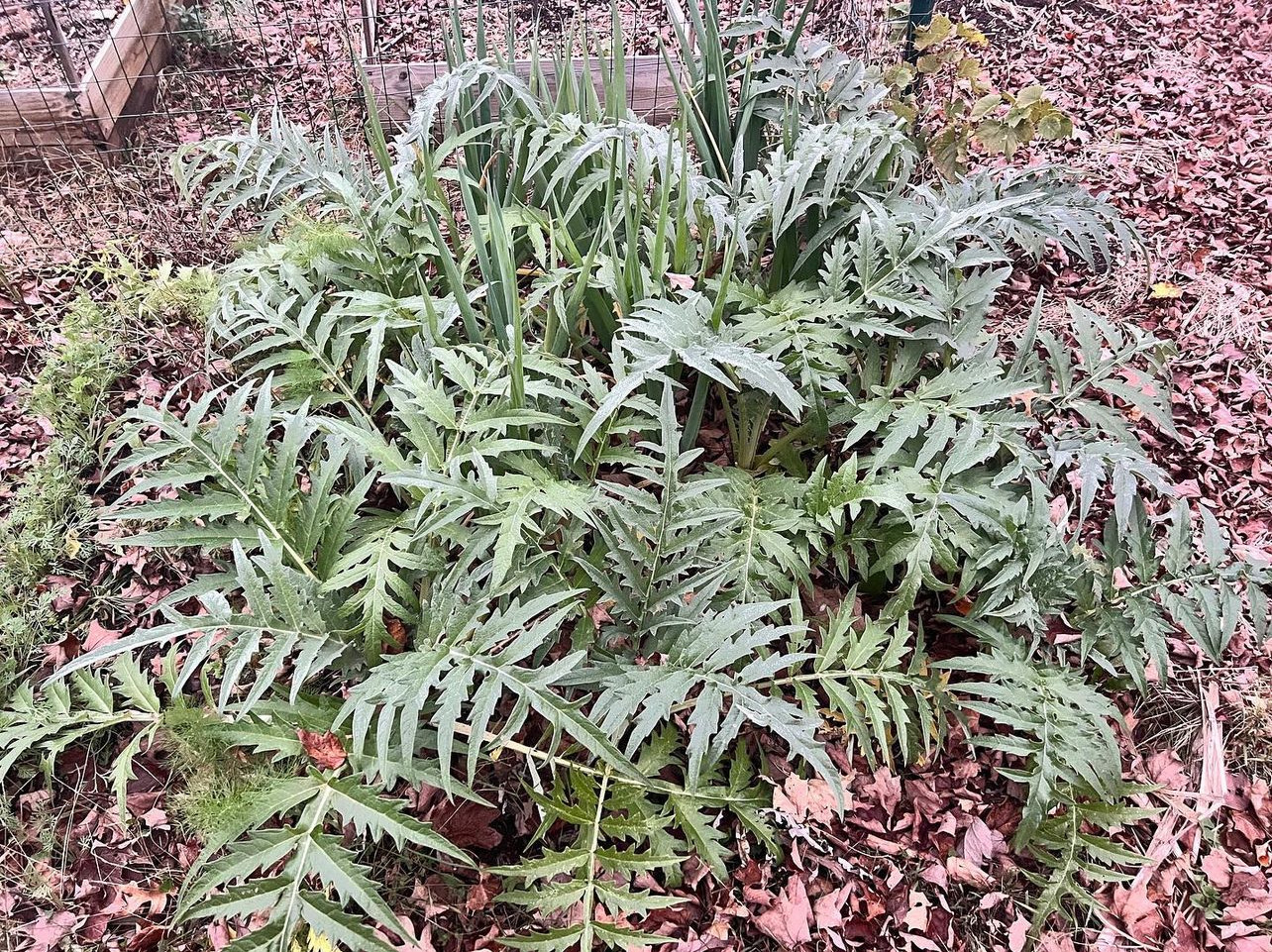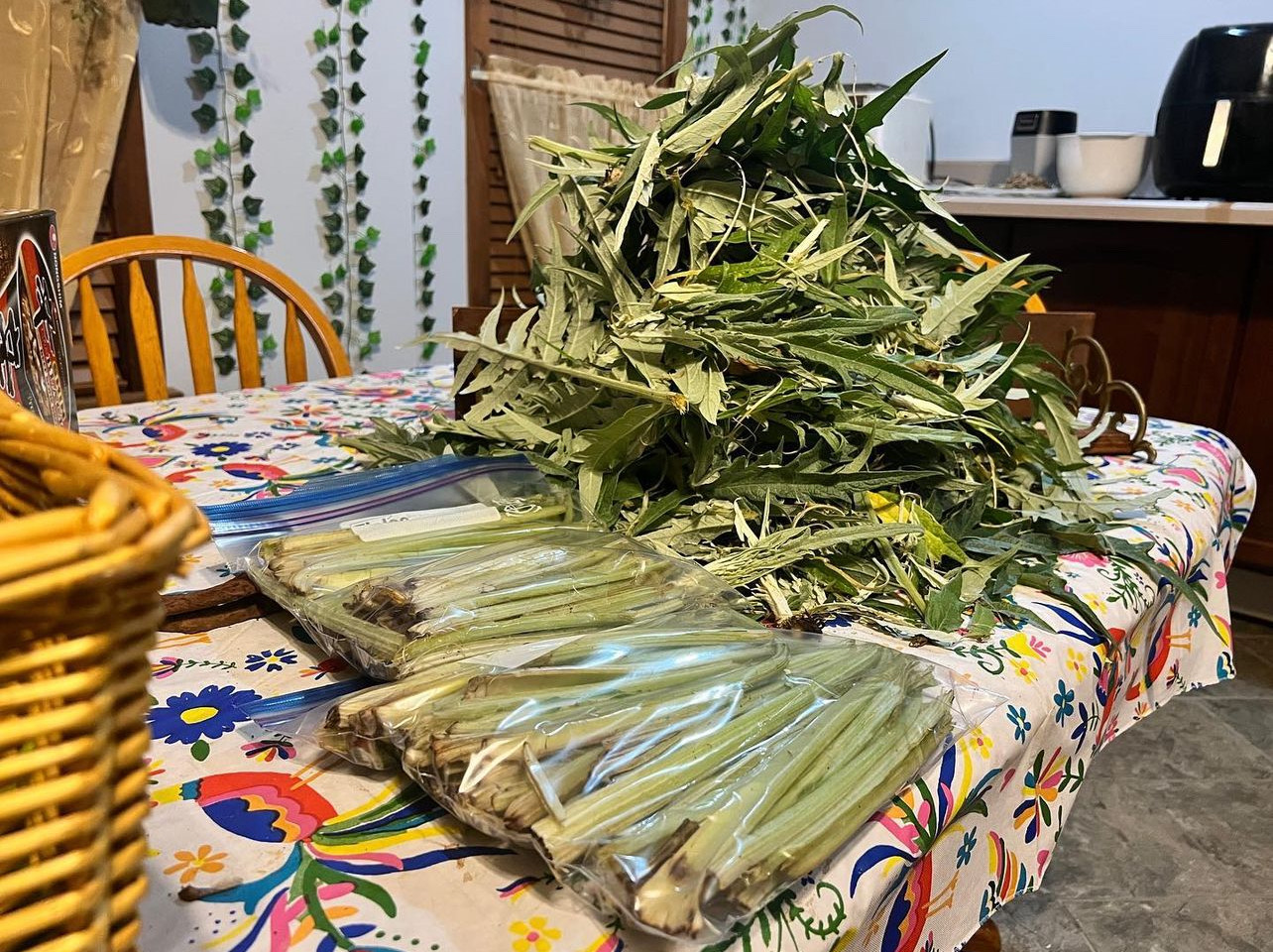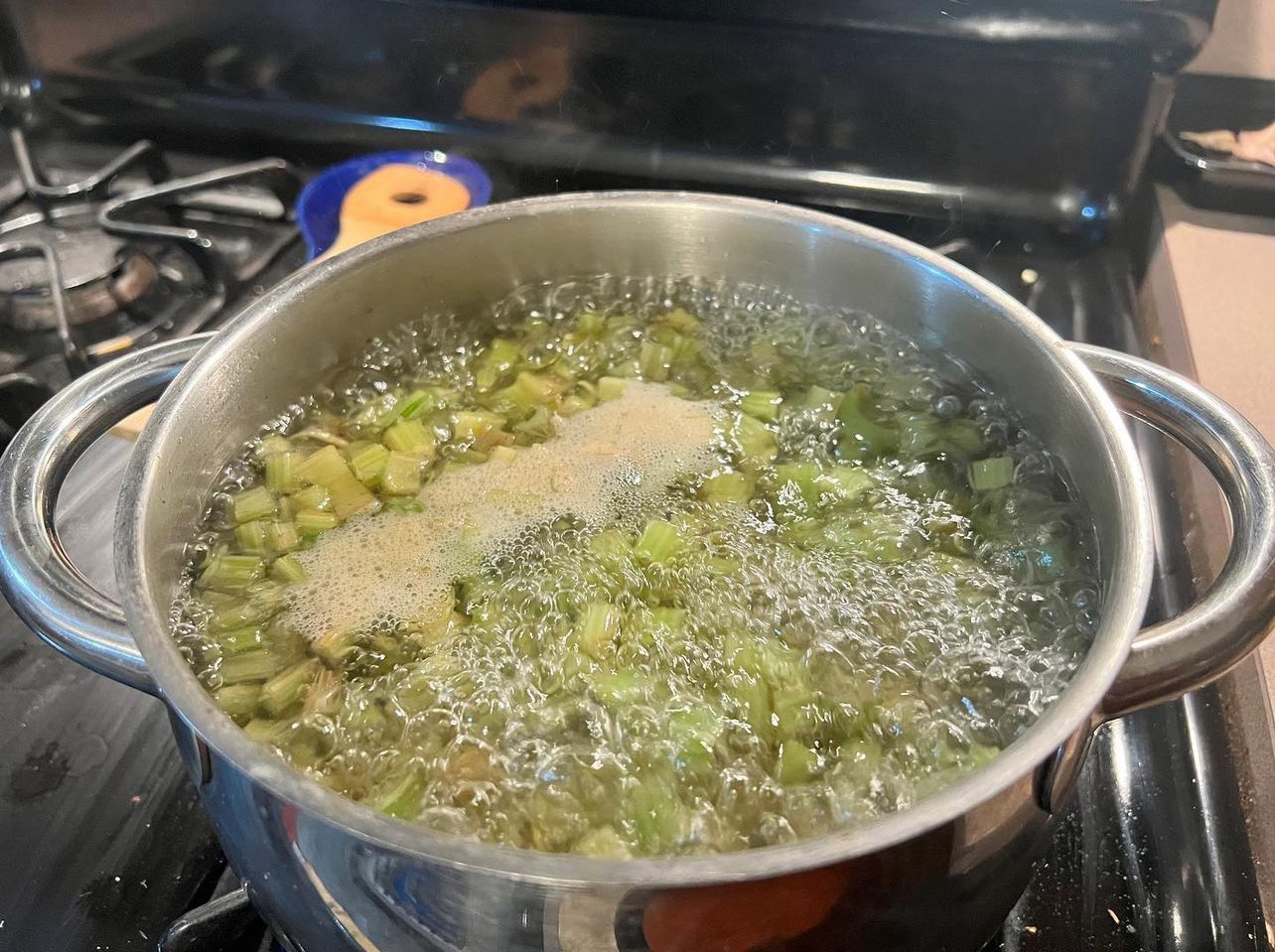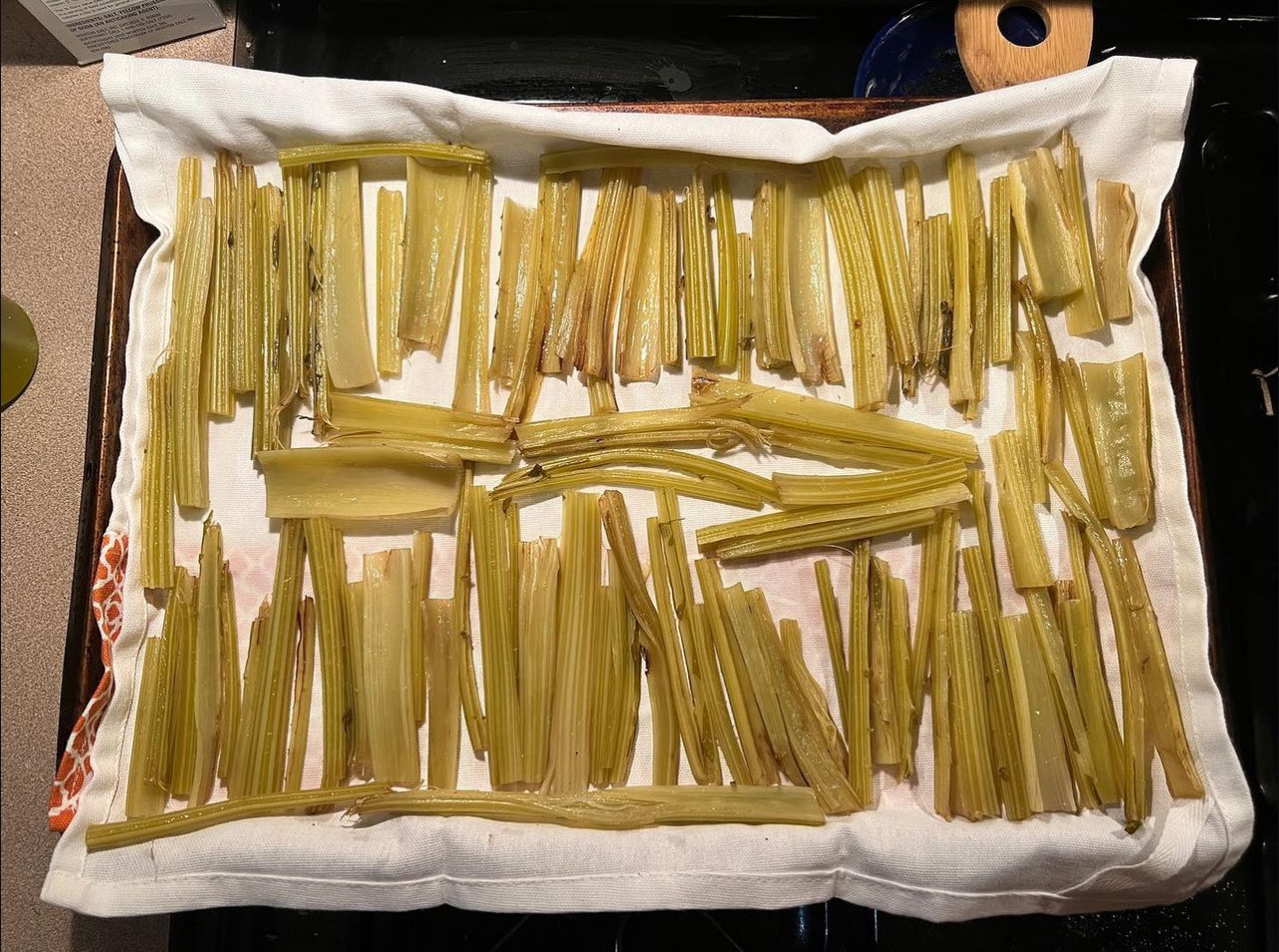A favorite among Sicilians but lesser known in the U.S., the artichoke's celery-resembling cousin, the cardoon (also known as artichoke thistle), is typically harvested after the first frost. That's when the otherwise bitter leafy green vegetable stalks are at their sweetest, says Westfield, Massachusetts, gardener Chrissy Saraceno.
She and her husband, Greg Russian, tend to a half-acre garden and run the Galaxy Gardens YouTube channel to educate aspiring gardeners and homesteaders.
Chrissy was inspired by her grandparents, who came to the U.S. from Melilli, Sicily, in the 1960s. Both had green thumbs and her grandmother gardens to this day.
Chrissy sees growing cardoons as a way to connect with her Sicilian roots, and she shared more about growing and cooking this unique, tasty vegetable with me.
Tell us about Galaxy Gardens.
Galaxy Gardens came up through the pandemic. Because I do a lot of gardening, my family kept asking me questions. Eventually, I was like, "You know what? I'm going to put it all in one spot for you, so if you have questions, I have some videos to refer you to so I don't have to keep repeating myself."
I really enjoy providing free education, so I've continued it. I'd really love to get into consulting in the future.
Describe your garden.
We're on about half an acre. Our main raised garden bed area is about 20 feet by 40 feet large. We have 16 raised beds. They're each six feet by three feet and about 11 inches deep. And then we have since foodscaped the rest of our property. So, right around our house, we have horseradishes, gooseberries, and valerian. We've added a couple more beds, and we're about at capacity for our property right now. But it's been really nice since we purchased a home to be able to actually foodscape our property. We have a small orchard in the back as well, and we have some chickens, too. It's been a very involved project the last few years, but now we're fully set up and really just have to worry about maintaining nutrient levels.
What is a cardoon?
A cardoon is in the artichoke family. However, it grows in stalks rather than producing the flower head that you harvest with artichokes. It loves nitrogen; it's a very slow grower. It tends to stay very small until about August or so, and then it'll go through a big growth spurt. So you'll get three- or four-foot tall plants that just keep going until it gets too cold out. And if you wait for the first frost to come and harvest, they tend to be a bit sweeter and slightly less bitter than if you harvest it when it's still warm.
Full-size cardoons. Photo by Galaxy Gardens
How did you start growing cardoons?
I really wanted to push our gardening zone limits on our property, which is in a Zone 6B area. Obviously, we get snow here in Massachusetts, but different parts of the property tend to stay warmer than others.
Over the years, my goal has been to experiment with all these different types of foods and just see what grows best here. I originally wanted to grow artichokes, but artichokes just don't last. Sometimes, we get early falls and a cold snap in September, and cardoons are a little hardier.
Why do you like growing them?
Honestly, the easiest, lowest-risk, and highest-reward thing you can grow is garlic. And second to that, now that I've grown it for several seasons, are cardoons.
If you try lettuce, you can look at it the wrong way when it's a seedling, and it will wilt on you. Cardoons are hardier. They're more forgiving. You just set them and forget them.
They are great if you just want something that's passively growing on the side, and you don't need to give it too much attention until it gets around harvest season. And it's a beautiful landscaping plant. My brother and his wife have it right on the corner of their house. It's this huge, sprawling bunch right now.
You can use the plant not only for landscaping purposes but also so that at the end of the year when you're going to be taking out or cutting down your landscaping plants anyway, you have food for your table.
How do you grow and harvest this vegetable?
You can start them inside in April, move them outside, and they'll grow all summer. I harvest them around October or November, and they do okay, even on frosty mornings.
You harvest it like you do celery, where you can cut them at the bottom.
We grow the spineless variety. When you harvest it and clean it up, it's very stringy. So it's kind of like stringing beans: You just need to pull the one big string off of it.
The spineless variety is more tender. After you clean up all the leaves, you just need to prepare it to eat, and you don't have to worry about any really tough textures on it.
Preparing cardoons post-harvest. Photo by Galaxy Gardens
What part do you eat?
The main stalk. When you finish processing, it looks like celery. It will grow in bunches, and as you separate the stalks from each other, you just go to the point where it's still thick and malleable, and you can remove the leaves. It has a fuzzy coating, but you can peel that off very easily. So then you'll end up with a four-foot plant with about a foot to a foot and a half stalk in the entire bunch. We grew about 12 plants last year. After processing, we ended up with two gallons of stalks to use.
Can cardoons be eaten raw?
I wouldn't recommend it! To be safe, once you have them harvested and processed, you would just boil them for about 15 to 20 minutes with some lemon juice and salt added to the water. And then, of course, blanch them and add some ice water to stop the cooking process. You can use them from there.
Boiling cardoons. Photo by Galaxy Gardens
What do they taste like?
The stalks taste like the most tender artichoke you've had. It's just a different texture that you're dealing with. They're sweet and almost a little bit nutty. Pine nuts would go very well with them.
When you cook cardoons, they really maintain that sweet flavor. It really comes through in anything that you make with them.
Blanched cardoons. Photo by Galaxy Gardens
What are your favorite ways to prepare them?
I actually have some left over from last year. I was hoping to make a leek-style soup with them, but my go-to is just to batter them. You could bake or fry them and make a nice dip to go with them. It's a really good appetizer.
What advice do you have for someone new to growing cardoons?
Start them inside. It depends on where you live. I have tried directly sowing them, and they actually like more water than you might expect. Cardoons do best in very fluffy and moist soil. By the time they come up, we have chipmunks and squirrels stealing them. So we start them inside. They're very easy. You can directly sow them in a cup, and they sprout within a day or so. We use LED lights that keep things pretty warm. They'll sprout in a couple of days and usually get between six and eight inches tall. But the plants themselves, once they get between two and four leaves, tend to stay there for even a month or two when you start them inside. By the time they're ready to go outside, they're pretty easy to transplant. You don't have to worry about breaking the roots. They're pretty hardy.
Once you transplant them, you can see where the stalks are already starting to come out. Just stick them so they are standing straight up in the ground and make sure they're well watered. They may wilt slightly in the sun if you are too fast with transitioning them outside. But once they're transplanted, they take a week or so to get established, and they'll grow a little bit more over the next month. They pretty much stay there until about August or September. Then, they decide to take off and continue with most of their growth.
What do you hope people take away from your gardening videos?
Gardening is a lot of work, but it's only as difficult as you make it for yourself. I think a lot of people lack the confidence to experiment with what they're growing. I hope they can see that we are just two regular people. There's nothing too special about the process that we're doing. They can try that at home.
If you enjoyed this article, consider subscribing to my newsletter for more content and updates!




